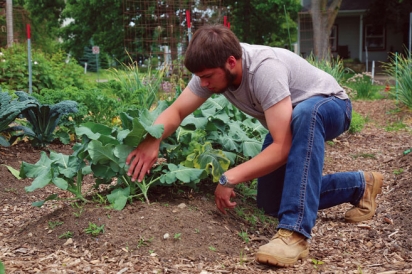A Taste of Home
Iowa colleges expand their local food sourcing efforts
Back in the early 1900s, Luther College was a hub of agricultural activity. The Decorah academic institution had chickens, hogs and a dairy herd, and students helped maintain gardens that supplied fresh fruits and vegetables for the campus.
“Like many schools in the region, I think, Luther grew a lot of its own food,” says Maren Beard, sustainable foods educator at the college. “We got away from that, but it’s in our deep history.”
By the time Beard graduated from Luther a century later, in 2008, the school was looking to return to those roots. College leaders had outlined a strategic plan with ambitious sustainability and local food sourcing goals. While just one percent of its food came from area producers at the time, Luther’s administrators aimed to raise that to 35 percent by 2013.
Five years after adopting the plan, the college exceeded its goal. That year, a full 36.3 percent of its ingredients were from purveyors within 100 miles of Decorah.
“When there’s a goal in place, it really does set things rolling in a way that wouldn’t be possible otherwise,” Beard says.
Luther is one of several small Iowa colleges prioritizing local buying in recent years. The school has also hosted several workshops where chefs and food service administrators from Iowa, Wisconsin and Minnesota gather to share ideas. Collectively, their purchases create jobs and impact small-town economies throughout the region. A 2014 report by the Leopold Center for Sustainable Agriculture at Iowa State University documents the increase in local food buys by colleges, K-12 schools, hospitals, nursing homes and other institutions, from nearly $9 million in 2012 to $13.1 million in 2013.
With a food service team plating close to 5,000 meals per day during the height of the school year, and supplying on-campus cafés and catering needs, Luther’s food purchases add up quickly. Beard says the college spent about $500,000 on local ingredients in 2013. That includes meat, produce and dairy products from outfits like northeast Iowa’s Grown Locally cooperative, Waukon’s WW Homestead Dairy and Country View Dairy in Hawkeye.
“We used to buy yogurt from a regional dairy distributor. It was good and students liked it, and we were buying 600 pounds per week. When we switched to yogurt from Country View Dairy, that spiked to 1,000 pounds per week because the kids liked it so much,” says Beard.
Luther administrators are now updating the school’s food sourcing goals, she adds, and those new guidelines will extend the definition of “local” to about 200 miles from Decorah. In addition to reducing food waste and increasing the nutritional value in campus eateries, the school intends to buy even more local products in specific categories – potentially as much as 75 percent of its dairy, 50 percent of meat and 25 percent of produce from local farmers, Beard explains.
To reach these goals, school representatives work with area producers and with Sodexo, the company managing campus dining operations, to review purchasing records and plan ahead for each growing season. Some menu items are created around available ingredients; for others, the college requests particular amounts of specific fruits or vegetables. When there are gaps between what’s been ordered and what’s available, the school often rounds out its shopping list by ordering from a national distributor.
“You can never estimate exactly what you’ll need or what a field is going to produce, so there are discrepancies sometimes,” Beard says. “But, this is our way of trying to give growers a secure market for their products.”
The college also grows some staples and specialty items on a one-acre plot on the Luther farm, about a mile from campus. Last year, gardens here supplied squash, tomatoes and greens, along with nearly 800 pounds of rutabaga used for the college’s annual holiday dinners. Recently, a new high tunnel growing structure was installed on tracks at the farm. It can be moved into three different positions, which further extends the growing season and boosts production. The goal is to supplement harvests from local growers while also introducing new menu options such as multicolored carrots and cherry tomatoes in various flavors.
A number of Luther students help in those production gardens as part of their work-study arrangements. Additional community gardens, edible campus landscapes and a cafeteria-to-community food donation program connect students, staff and faculty members to the local food system, too. Plus, more than 25 percent of the college’s employees participate in a community-supported agriculture (CSA) rebate program that makes local produce more affordable. The initiative increases access to nutritious foods, while raising awareness.
“Food is one of those easy entry points. Everyone needs to eat, and it’s an easy touch point for people in terms of sustainability,” says Beard.
Linking the campus community to local sourcing efforts is also a priority at Cornell College, where the culinary team will host an eat local challenge this September and a harvest festival in October. The Mount Vernon school presents monthly and annual educational programs related to the local food system, as well.
Bon Appétit Management Company oversees dining services at Cornell, where more than 20 percent of the food served comes from area producers. Manager Joan Homrich and her team are working to increase that to 35 percent in the next five years.
“Many large cafeterias and cafés tend to use canned goods. We personally don’t use those items. If we are serving corn, it’s real corn that’s not out of a can,” she says. “Our commitment is to local, to farmers, to cooking from scratch.”
Homrich looks to neighboring producers for everything from chicken, eggs, dairy and potatoes, to beans, tomatoes, apples and garlic. Because many of those fruits and vegetables are chopped and cooked, the culinary team can buy perfectly good produce that’s imperfect in appearance. This gives growers new markets for goods that might not sell in stores.
“People don’t seem to mind the apple with a little blemish in it when they know it came from only 20 miles away and it was picked two days ago,” confirms Tom Wieseler, who manages the Sodexo dining team at Coe College in Cedar Rapids. He’s been leading campus sustainability efforts for 20 years. Sourcing locally is a fairly new initiative at Coe, but Wieseler already buys apples from Buffalo Ridge Orchard in Central City and purchases honey and eggs from area producers. He’s also exploring options for regionally-grown vegetables and grass-fed beef.
When it comes to purchasing local and organic ingredients, Wieseler admits that cost can be a challenge. Still, students and staff are increasingly requesting these options.
“The discerning customers will say, ‘This is how apples should taste.’ Take a cherry tomato picked out of the garden versus a cherry tomato that’s been on a truck. There’s a whole level of sweetness…that’s ideal,” he says.
For customers who are less informed in such matters, local foods can be an important educational tool. Central College student Collin Strickland says some of his peers don’t know where their food comes from or how it’s grown.
“I’ve taken some of my fellow students out to the garden to say, ‘Hey, this is what kale looks like.’ They have no idea what it even looks like as a plant,” says the environmental science and biology major. He’s tackling the issue by steering the Pella institution through the Real Food Challenge. The national campaign helps colleges evaluate their purchases and prioritize local, fair, ecologically sound and humane ingredients.
In addition to assessing Central’s food purchases, Strickland is talking to area farmers about what they’re growing and what the college is looking to buy. As more local foods are served in the dining hall and two campus cafés, the culinary team increasingly promotes growers and their harvests with signage and events.
“We’re just trying to be more proactive about letting students know when their food is from close by in Iowa,” Strickland says. “If we can have pictures of the farms, what the plants look like and where the food comes from, that’s going to help our students be more educated about what they’re eating and how Central is doing its part to be more sustainable.”
Seeing students like Strickland get involved with menu planning, food sourcing and gardening on campus is rewarding for Richard Phillips, director of dining services at Central. He commends faculty and staff members for engaging students and supporting local food efforts, and he credits producers, as well.
“The farmers themselves, especially the ones who are local to us, are so happy that we are so interested in this...Several want to come in and share their vision and their stories with students,” Phillips says.
He invites growers, nutritionists and other experts to talk food on campus during lunchtime “chat and chew” sessions, and he beefed up the college’s most recent local food day by exclusively serving ingredients produced within 20 miles of Pella. The menu included beef, pork, honey, butter, bread, salad items, squash and more.
“The creative juices started flowing,” says Phillips. “There’s more we can do locally, and we have to get past the stigma that you have to spend more money to go local. Sometimes you do, but it depends on volume, as well.”
He also controls costs by having student workers help clean carrots, prep potatoes and craft salsas from tomatoes that come into the kitchen. An expanded college garden supplies additional fresh ingredients.
Because Central’s sustainability team just started tracking its hometown food purchases this summer, Phillips can’t yet quantify the economic impact. Eventually, though, he’d like to catch up with the likes of Luther College and source at least a third of his ingredients locally. One of his current priorities is to find fresh, local ground beef for burgers.
“You’ve got to have some junk on the menu,” says Phillips with a laugh. “You can’t take away the French fries and the hamburger, but there’s a way to do it right...It’s going to take some time, but we’ll get there.”







